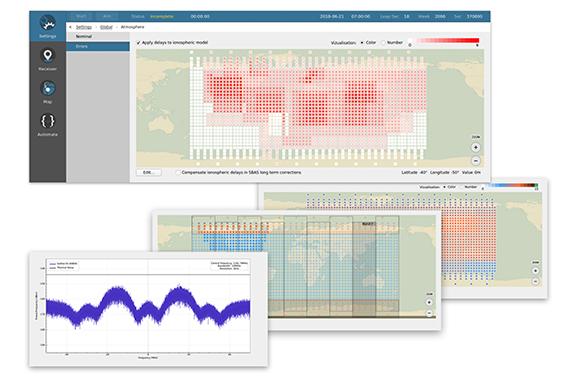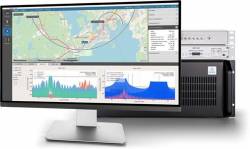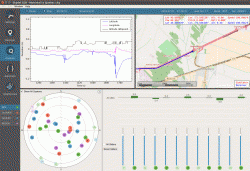Skydel Solutions recently released SDX 19.1, the eighteenth major revision of its GNSS Simulator. This newest GNSS simulator version adds Galileo AltBOC support, atmospheric errors, SBAS improvements, and GNSS satellite antenna patterns.
SDX now supports Galileo AltBOC as a new GNSS signal type. Current SDX users licensed with the Galileo E5 signal will be able to generate 8 Phase Shift Keying (8-PSK) constant envelope AltBOC after upgrading to SDX 19.1. The signal can be generated by selecting both Galileo E5a and E5b in the output – signal selection panel.
Atmospheric Delays/Improved SBAS
The company has added a new error type to all SDX users in release 19.1: atmospheric delays. Moreover, these errors can be compensated with SBAS for those SDX licensees with the SBAS option installed. The SBAS message now broadcasts ionospheric error corrections.
When a signal is broadcast from a GNSS satellite to the surface, a delay is introduced following how the signal propagates in the atmosphere. One of SBAS’ aims is to provide corrections to mitigate these delays (also called errors) in order to achieve a better positioning accuracy. SBAS accomplishes this by creating a virtual grid of points wrapped around the globe. Ground-based SBAS reference stations, located at known positions, compute corrections values for each point, which are in turn sent to, and broadcast by, the SBAS constellation. A GNSS receiver with SBAS enabled can then use the correction data relevant to its current position to compute a more accurate positioning solution. These points are called Ionospheric Grid Points (IGPs) and are organized into bands (numbered 0 to 10).
Skydel has added three new interfaces to help create, manage, and use these error values in simulation scenarios.
Atmospheric Errors
This panel enables users to review and edit the ionospheric delay values for any IGPs. The map view can be navigated (pan and zoom) much like the Map panel of the simulation. The edit button brings up an IGP editor used to assign the points values or increase their current value by a set amount. Since the number of points in the grid is fairly large, the user interface works with a selection of points, allowing the addition or to remove the current selection in order to quickly work your way around the whole map.
Atmospheric errors are available to all SDX licensees with the 19.1 upgrade.
SDX users with the SBAS option can use this new interface to assign the true/false value for each point of the different SBAS bands, per service provider. It reuses most of the paradigm of the aforementioned atmospheric error pane.
Using a similar map interface as the two previous panels, the GIVEI (GIVE Indicators) panel enables you to provide the GIVE Indicator values for each IGP that is configured in the mask, per service provider.
The grids created or modified with these new options can all be saved and imported back into future SDX scenarios.
New Antenna Patterns
Also new in SDX 19.1 is the possibility to add user-defined antenna patterns to GNSS satellites. These new antenna pattern options show SDX’s flexibility by allowing any user-defined antenna pattern to be applied to any satellites in any GNSS constellation, according to the company.
This can prove especially useful for scientists and engineers working with space vehicles, due to their unusual orientation when we compare them to surface vehicles. High-Earth-orbiting spacecraft benefit from the side lobes of GNSS satellites to improve navigation performance. In fact, when tracking the signal from side lobes, the number of visible satellites is drastically increased, and the precision can improve from the kilometer to the meter level.
In addition, Skydel states the new antenna patterns can be a potent tool in the context of research projects that experiment with user-defined GNSS SV Antennas.
SDX now allows you to create, define, and manage antenna patterns for GNSS satellites using an interface very similar to the one introduced for vehicles in SDX 18.10. As with that release, the various patterns are organized into antenna models that can be named, managed, exported, and reimported back into other simulation scenarios.
Rounding out the changes for this latest release, Skydel presents two user interface improvements. The first change is the addition of a “path” interface in the Settings menu.
Since the number of settings has grown since the initial SDX releases, this small UI widget helps in locating the current panel in the settings hierarchy, enabling you to jump back a few steps when in the lower settings level, saving a few clicks.
Moreover, it’s now possible to collapse the subtabs panel at the bottom of the screen in order to get a bit more real estate when working in the settings, map, or automate panel.






